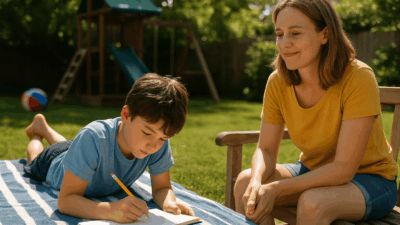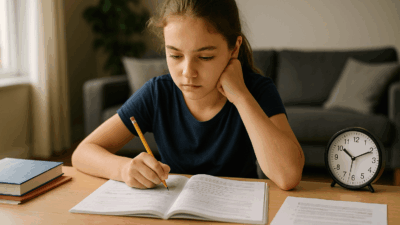For many children, the geometry section of the 11+ Maths exam can feel abstract and intimidating. Unlike straightforward arithmetic, it requires a different way of thinking: spatial reasoning, logic, and the ability to visualise and manipulate shapes in their minds.
However, the truth is that geometry is not a mysterious art; it’s a topic built on a foundation of clear, learnable rules and properties. Once your child masters these core principles, they can tackle any geometry question with confidence.
At elevenplus.com, we specialise in breaking down complex topics into manageable parts. This guide will provide you with a clear and simple overview of the three key areas of 11+ geometry—Shapes, Angles, and Coordinates—giving you the tools you need to support your child effectively.
In this definitive guide, you will learn:
- The key properties of 2D and 3D shapes that your child must know.
- The 4 essential angle rules that unlock most angle-based problems.
- A simple explanation of coordinates, reflection, and translation.
- Practical, hands-on tips to build your child’s spatial reasoning skills at home.
Pillar 1: Mastering Shapes (2D and 3D)
This is all about knowing the properties of common shapes and understanding how they are constructed.
2D Shapes
Your child needs to be able to identify and describe the properties of:
- Triangles:
- Equilateral: 3 equal sides, 3 equal angles (60° each).
- Isosceles: 2 equal sides, 2 equal base angles.
- Scalene: No equal sides, no equal angles.
- Quadrilaterals (4-sided shapes):
- Square: 4 equal sides, 4 right angles.
- Rectangle: 2 pairs of equal sides, 4 right angles.
- Rhombus: 4 equal sides, opposite angles are equal.
- Parallelogram: 2 pairs of equal sides, 2 pairs of parallel sides.
3D Shapes and Nets
For 3D shapes, your child should know their faces (the flat surfaces), edges, and vertices (corners). A common and tricky question type involves nets. A net is the 2D pattern that can be folded to make a 3D shape.
- The Key Skill: Being able to visualise folding the net in their mind to see if it forms a closed shape, most commonly a cube.
[Image: A diagram showing a 2D net of a cube and an arrow pointing to the folded 3D cube.]
Pillar 2: The Rules of Angles
Most angle problems in the 11+ can be solved by knowing just four simple rules. Once your child has memorised these, they can unlock almost any question.
- Angles on a Straight Line: Add up to 180°.
- Angles Around a Point: Add up to 360°.
- Angles in a Triangle: Add up to 180°.
- Angles in a Quadrilateral: Add up to 360°.
By applying these rules, often in combination, your child can calculate missing angles in complex diagrams.
Pillar 3: Position and Direction
This area tests your child’s ability to understand and describe the position of objects on a grid.
Coordinates
Your child needs to be comfortable reading and plotting coordinates in all four quadrants of a grid. Remember the rule: “Along the corridor, then up (or down) the stairs.”
- The first number (x-axis) is the horizontal position.
- The second number (y-axis) is the vertical position.
Reflection and Translation
- Reflection: This is like looking in a mirror. Your child will be asked to reflect a shape across a mirror line. Every point on the reflected shape will be the same distance from the mirror line as the original.
- Translation: This simply means sliding a shape from one position to another without rotating or flipping it. The question will usually give instructions like “move the shape 3 squares to the right and 2 squares up.”
How to Build Spatial Reasoning Skills at Home
You can develop these skills in a fun, practical way without it feeling like revision.
- Use Building Blocks: Playing with LEGO, blocks, or even magnetic tiles is one of the best ways to develop an intuitive understanding of 3D shapes and how they fit together.
- Look for Shapes in the Real World: Turn a walk into a game. “How many rectangles can you spot?” “What shape is that sign?” Look at a cereal box and count its faces, edges, and vertices.
- Get Hands-On with Nets: Print out a few different nets of a cube from the internet. Cut them out and see which ones actually fold into a cube. This hands-on experience is far more memorable than just looking at them on a page.
- Play Battleships: The classic board game is a fantastic and fun way to practice reading and calling out coordinates.
From Abstract to Achievable
Geometry doesn’t have to be intimidating. By breaking it down into these three pillars and reinforcing the concepts with practical, hands-on activities, you can help your child build the skills and confidence they need to master this crucial part of the 11+ Maths exam.
Ready to put these skills to the test?
➡️ Our 11+ Maths Practice Packs include a wide range of geometry questions, from identifying shapes to solving complex angle problems, all designed to build confidence and exam technique.



